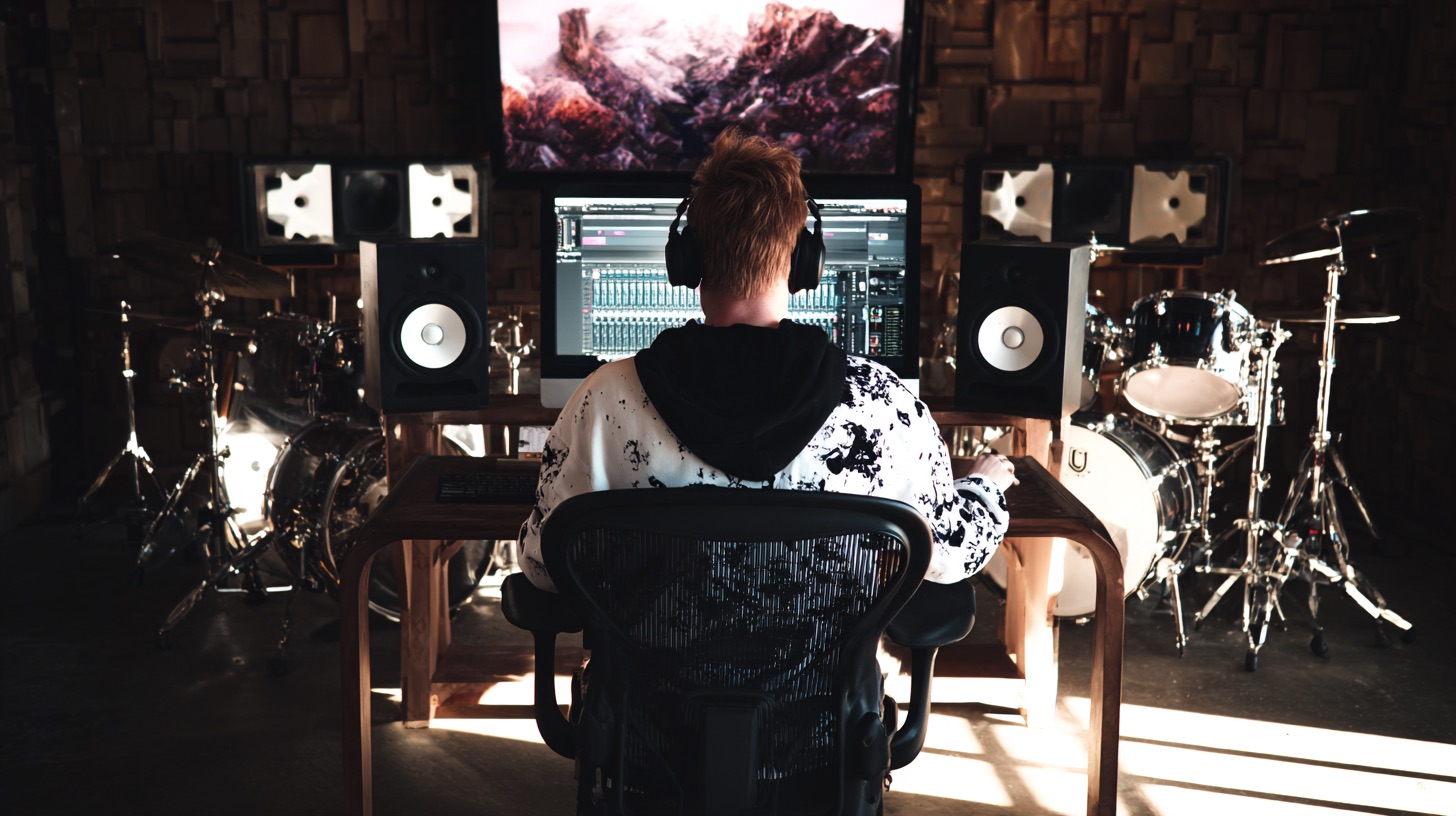
How to Use Gain Staging for Punchier Modern Metal Mixes
Nail The Mix Staff
Gain staging. You’ve probably heard the term, maybe even rolled your eyes thinking it’s some dusty old concept from the analog days. In an era where DAWs give us seemingly infinite headroom and the noise floor is a distant memory, does meticulously managing levels really matter for modern metal production?
Short answer: Hell yeah, it absolutely does. Especially in modern metal, where the expectation is sky-high for polished, dense, and face-meltingly heavy productions. Whether you’re wrangling 8-string guitars tuned to the earth’s core, layering synths like Bring Me The Horizon, or programming drums that sound like they were forged by Thor himself using GetGood Drums, proper gain staging is your unsung hero. It’s the foundation for clarity, punch, and making sure all those killer plugins you own actually sound, well, killer.
So, What Exactly IS Gain Staging in the Box?
Think of gain staging as managing the volume of your audio signal at every single point it passes through. From the moment your guitar DI hits your Focusrite Scarlett or Universal Audio Apollo interface, through every plugin on your channel strip in Pro Tools, Logic Pro X, or Reaper, onto your busses, and finally to your master fader – every step is a “stage.”
“But digital is clean! I can just turn it down later!” I hear ya. While it’s true you don’t have to worry about tape hiss or console noise like back in the day, ignoring gain staging in your DAW is like trying to build a skyscraper on a shaky foundation. Here’s why it’s still crucial:
- Plugin Sweet Spots: This is a big one. Many plugins, especially those emulating classic analog gear (think Waves CLA-76 compressors, Pultec EQP-1A style EQs from Plugin Alliance, or tape saturation from Soundtoys Decapitator), are designed to react optimally when they receive an input signal around -18dBFS RMS. This mimics the 0VU level on vintage consoles. Feed them too hot, and they might distort undesirably or behave erratically. Too quiet, and you might not get the character or control you’re after.
- Headroom, Headroom, Headroom: Modern metal is LOUD, but it also needs to be DYNAMIC (at least, dynamically impactful). Good gain staging ensures you have enough headroom on individual tracks, busses, and crucially, your master bus. This prevents nasty digital clipping and gives your mix space to breathe, especially before it hits mastering.
- Fader Resolution & Mix Bus Magic: If all your tracks are screaming hot, your faders will live down in the basement, making tiny, precise adjustments a nightmare. Properly staged tracks hitting your mix bus (maybe with an SSL G-Comp style plugin) at sensible levels means your bus processing works more effectively, giving you that cohesive “glue.”
- Avoiding Nasty Surprises (Inter-Sample Peaks): Even if your track meters aren’t hitting red, super hot signals can cause inter-sample peaks when your audio is converted back to analog for playback. This means distortion that you didn’t intend and can’t always see on your DAW meters.
Gain Staging Your Tracks: From DI to Devastation
Let’s walk through how to apply this to your modern metal workflow.
Nailing Input Levels: The First Stand
Getting it right at the source is paramount.
- DIs (Guitar & Bass): When plugging your 7, 8, or even 9-string guitar or bass directly into your interface, aim for your raw DI signal to peak somewhere between -18dBFS and -12dBFS. This gives amp sims like those from Neural DSP (Archetype: Gojira, Archetype: Petrucci, etc.) or STL Tones ToneHub the kind of level they expect. Too hot into an amp sim can result in a fizzy, compressed mess that no amount of EQ can fix. (And if you recorded too hot, don’t worry—you can often salvage clipped DIs). Too low, and it’ll sound weak and anemic. Use the input gain on your interface.
- Mics (Vocals, Live Drums, Cabs): Same deal. If you’re micing a screaming vocalist or a thunderous drum kit, watch those preamp levels on your interface or external preamps (like a trusty Neve 1073 clone). Modern metal vocals can be incredibly dynamic; capture that range without clipping!
In The Box: Taming Levels Before Plugins
Once your audio is in the DAW, your first tool is usually Clip Gain (Pro Tools), Region Gain/Volume (Logic, Cubase), or Item Volume (Reaper).
- Clip Gain is Your Best Friend: Before you even think about slapping on an EQ or compressor, use clip gain to even out wildly dynamic parts. Got a palm mute that’s way louder than a sustained chord? Clip gain it down. This means your first plugin isn’t getting slammed unexpectedly.
- Amp Sims & IR Loaders: After your DI is level, the amp sim is often next. Most amp sims (like the aforementioned Neural DSP plugins) have their own input and output gain controls. Use the input to fine-tune how hard you’re hitting the virtual "amp," and the output to ensure the signal leaving the amp sim is at a healthy level for the next plugin (e.g., a Cab IR loader like NadIR or the built-in ones in your sim).
Weaving Through Your Plugin Chain
This is where consistency is key.
- The -18dBFS RMS Guideline: For analog-modeled plugins, aim for an average level of around -18dBFS RMS hitting their input. Grab a VU meter plugin (like the free TBProAudio mvMeter2 or Klanghelm VUMT) and place it before the plugin to check.
- EQs: Vintage-style EQs (think Pultecs, Neves) can add subtle saturation or change their curve behavior if hit too hard. While modern EQs like FabFilter Pro-Q 3 are generally cleaner, maintaining consistent gain helps you judge your EQ moves accurately. For more on metal EQ, check out our EQ Strategies for Mixing Modern Metal hub page.
- Compressors: A compressor’s threshold is entirely level-dependent. If your snare track is all over the place volume-wise, your Waves CLA-76 or Arturia FET-76 will react inconsistently. Stage it properly, and your compressor settings will make sense and deliver that punch. Want to dive deeper into metal compression? Our Metal Compression Secrets hub page has you covered.
- Saturation/Distortion: Plugins like FabFilter Saturn 2 or the classic Soundtoys Decapitator are extremely sensitive to input levels. Small changes in input gain can drastically alter the amount and character of saturation. Pay close attention here!
- USE THE OUTPUT KNOB! Almost every plugin has an output gain/trim. After you’ve dialed in your sound, adjust this output so the level leaving the plugin is roughly the same as the level entering it (unless you’re intentionally boosting or cutting for effect). This is called "unity gain" and makes A/B testing your processing much more objective.
Gain Staging for Modern Metal’s Unique Demands
Taming the Low-End Beast (Low Tunings & Extended Range Guitars)
Those F# and lower tunings on 8-string guitars are sick, but they generate HUGE amounts of low-frequency energy.
- Headroom Hog: Without careful gain staging, this colossal low-end from multiple guitar tracks can eat up your headroom on busses and the master fader in no time, leading to a muddy, undefined mix.
- Clarity is Key: By managing levels at each stage, you prevent individual low-tuned sources from overwhelming the mix. This allows your EQs (check that EQ hub page!) to do their job effectively without fighting overly hot signals. Use a spectrum analyzer like the free Voxengo SPAN to see what’s happening down there.
Achieving Clarity in Density (The "Polished Production" Standard)
Modern metal often features incredibly dense arrangements – quad-tracked guitars, intricate programmed drums from libraries like Superior Drummer 3 or GetGood Drums, layers of synths, maybe even orchestral elements.
- No Room for Sloppiness: The expectation for "extremely polished production" means every element needs its own space. If every track is pushed to the max, you get a distorted, ear-fatiguing mess. Proper gain staging ensures each layer contributes clearly without fighting for loudness.
Drum Samples & Programmed Drums: Still Needs Finesse
Even if you’re using pristine drum samples, gain staging matters.
- Internal Sampler Mixers: Drum samplers like GGD or SD3 have their own internal mixers. Balance the kit pieces there first. Maybe your GGD PIV Matt Halpern snare is perfect, but the overheads are a bit hot. Adjust it in the sampler before it even hits your DAW channel.
- Bus Processing Power: Getting your drum shells, overheads, and room mics individually gain-staged correctly means they’ll hit your drum bus compressor (perhaps an API 2500 emulation) at the optimum level for that cohesive, punchy sound that defines modern metal drums.
A Practical Gain Staging Workflow for Your Metal Mixes
- Prep Your Session: Before you even start mixing, bring all your track faders to 0dB (unity). Use clip gain/region gain to get your raw tracks averaging around -18dBFS RMS (or peaking around -12dBFS to -10dBFS for more transient material like drums). This sets a clean baseline.
- Plugin by Plugin: As you add plugins, keep an eye on those input and output levels. Use that VU meter! Adjust the plugin’s output gain to match its input level (unity gain) unless you have a specific reason not to.
- Bus Levels: As you send tracks to busses (drum bus, guitar bus, vocal bus), make sure these busses aren’t clipping and have plenty of headroom (aim for peaks around -12dBFS to -6dBFS). This leaves room for bus processing.
- Master Fader = Sacred Ground: Your master fader should never clip. Ever. Aim to leave at least -6dBFS of headroom on your master bus before any final limiting for loudness to hit your target LUFS. This gives mastering (whether by you or a pro) room to work.
The Payoff: Why This "Boring" Stuff Crushes
So, why go through all this meticulous level management?
- Punchier, Clearer Mixes: This is the big one. Your elements will have space, definition, and impact.
- Plugins Sound As Intended: You’ll unlock the true character of your analog emulation plugins.
- Massive Headroom: No more fighting digital clipping or squashed dynamics.
- That Polished Sound: It’s a huge step towards achieving that professional, modern metal sound demanded by today’s standards.
- Smoother Workflow: Fewer surprises, easier automation, and more predictable results when using advanced techniques.
Gain staging isn’t the flashiest part of mixing, but it’s a fundamental skill that separates the amateur from the pro. It’s the bedrock upon which all those killer tones, crushing drums, and soaring vocals are built.
Want to see how the pros who mix bands like Meshuggah, Periphery, and Architects handle not just gain staging, but every single decision that goes into a world-class metal mix? At Nail The Mix, you get to be a fly on the wall. Every month, we deliver the actual multitracks from massive metal songs, and you get to watch the original producer mix it from scratch, explaining their entire process.
If you’re ready to take your modern metal productions to the next level and truly understand how these polished, powerful records are made, then it’s time to Unlock Your Sound: Mixing Modern Metal Beyond Presets with Nail The Mix. Stop guessing and start learning from the best in the game.
Get a new set of multi-tracks every month from a world-class artist, a livestream with the producer who mixed it, 100+ tutorials, our exclusive plugins and more
Get Started for $1






